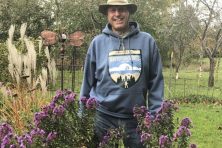Now Is the Time to Start Seeds Indoors
- Share
- Tweet
- Pin
- Share

As the days get longer, avid gardeners are thinking about one thing: planting season.
While it might be tempting to throw out seeds the second temperatures reach 60, there still is a lot of potentially cold weather ahead. If you just can’t wait to start growing plants, the best thing to do is to start seeds inside.
The advantages of starting seeds indoors is that you have access to a wide variety of cultivars that may not be sold in stores. Starting seeds inside is also beneficial because our growing season isn’t very long, so giving the plants a head start can potentially lead to a more abundant harvest.
When starting seeds inside it is important to remember the basic needs of a plant: soil or some type of growth media, water, light and fertilizer. Reducing the likelihood of disease is also crucial for success.
The first step is to gather all the necessary materials. Plastic trays with inserts containing multiple cells are the best way to start seeds since the roots of the seedlings will not get twisted around each other, reducing the amount of damage to the roots when transplanted. Additionally, each cell must have a hole in the bottom to allow for good drainage. Precautions need to be taken when re-using plastic trays, however, because the trays often harbor disease-causing agents that will cause the roots of the new seedlings to rot (damping off). In order to reduce the likelihood of damping off, all trays should be sterilized before use. Plastic trays can be sterilized by soaking them in a bleach solution (follow the label on the bottle) for 30 minutes. Even with this measure, it is often best to purchase new trays each year.
Good drainage is crucial for the survival of the seedlings. Soilless potting mixtures are typically recommended because they are lightweight, sterile, and have good drainage. Commercial mixtures are sold at most garden centers, but you can also create your own using a mixture of 1/3 peat or sphagnum moss, 1/3 compost, and 1/3 vermiculite or perlite. Regardless of whether you purchase or make your own potting mixture, place it in a bucket or other large container and add water. Stir it until the mixture is damp and then fill your planting cells. If you plant seeds into dry potting mix, it won’t absorb water very well and can push the seed out of the media.
Once the plastic cells are sterilized and you have wet the potting mix, fill each cell to the surface and you are ready to plant. Follow the label on the seed package to ensure you use the proper planting depth. Do not plant seeds too deep. Planting seeds too deep is a very common mistake that will lead to a reduction in the number of plants that survive. Once seeds are planted, the soil should be kept damp. A spray bottle with water can be an efficient way to keep the soil damp, but reduce the risk of overwatering. Any water that drains through the cells into the tray below should be poured off. Seedlings grown in a soilless media can benefit from occasional fertilization – a one-quarter dilution of a general purpose water-soluble fertilizer used once a week is enough.
The last critical step for starting seeds inside is the plants must have adequate light. Around here, supplemental light sources are almost always needed. If there isn’t adequate light, the seedlings will be “leggy,” where their first leaves are at the end of a long, weak stem. When grown with proper light, the first leaves will be right above the soil surface. There are lights that are sold as “grow lights” which work well, but “cool white” florescent lights or LED lights are good, too.
The lights should be hung so they are between two to four inches above the plants. They should be raised up as the plants grow to maintain that distance.
The ideal time to start seeds varies by the plant being grown and the average frost-free date of the location where the plants will be transplanted. In Door County, the average frost-free date is around May 12, so that date should be used when you determine how far in advance you should start seeds.
Even though May 12 is the average time, the last frost can be well before or after that date, but use extreme caution if you plant much before that time. Before transplanting the seedlings, make sure to harden them off by putting the trays outside for increasing amounts of time the week or two before transplanting. This will allow them to acclimate to outdoor conditions and prevent sunburn.
If you have never attempted to start your own seeds, there is no better time than now to try it out!
If you have any questions about starting seeds indoors or would like more information, contact the Door County Extension Office at 920.746.2260. Planting calendars and additional resources are also posted at door.uwex.edu/horticulture.



